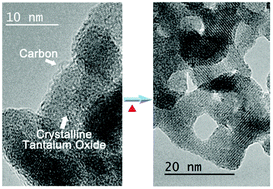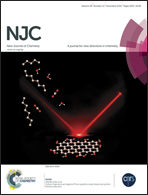In situ carbonization of a soft-template to directly synthesize crystalline mesoporous metal oxides with high surface areas†
Abstract
High-surface-area crystalline mesoporous d0 metal oxides such as Ta2O5, Nb2O5, and TiO2 were synthesized via a one-pot method using pluronic triblock copolymer P-123 as a structure directing agent. Mesostructure stability during metal oxide crystallization via high temperature calcination is difficult to maintain in such synthesis. In this study, two heat treatments were proven to play a key role in achieving this goal. The first one is the intermediate heat treatment that preconsolidates the mesostructure and partially decomposes P-123 into carbon-rich species. The second heat treatment relies on high temperature calcination under an inert atmosphere to simultaneously form carbon wrapping on the metal oxides in situ and achieve crystallization of metal oxides. These two treatments successfully restricted the porous structure collapse and crystal size growth during high temperature crystallization. The as-synthesized crystalline mesoporous metal oxides show disordered mesoporous structures consisting of polycrystals. Notably, the commonly used P-123 surfactant without the sp2-hybridized carbon forms much amorphous carbon in situ, which effectively restricts mass transfer during crystallization and thus successfully prevents crystal size growth. The as-synthesized crystalline mesoporous Ta2O5, Nb2O5, and TiO2 displayed surface areas of 117.0, 125, and 76.2 m2 g−1, respectively, and pore sizes of 5.4, 8.1, and 13.9 nm, respectively. Crystal sizes amounted to 19, 28, and 34 nm for mesoporous Ta2O5, Nb2O5, and TiO2, respectively. Porous and crystal structures of the as-synthesized samples are characterized using X-ray diffraction, thermogravimetric-differential thermal analysis, scanning electron microscopy, transmission electron microscopy, X-ray photoelectron spectroscopy, and N2 sorption techniques. The photocatalytic performance of the as-synthesized crystalline mesoporous Ta2O5 is also evaluated. Using NiOx as a cocatalyst, the as-prepared crystalline mesoporous Ta2O5 showed stable overall water splitting under Xe lamp irradiation (full arc). When the light intensity is fixed at 0.17–0.18 W cm−2, the highest H2 evolution rate is 709.1 μmol g−1 h−1.


 Please wait while we load your content...
Please wait while we load your content...